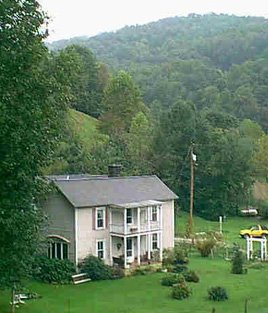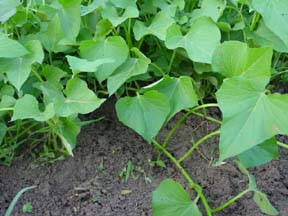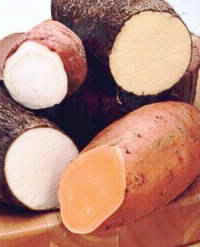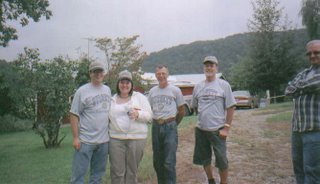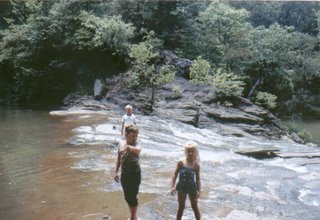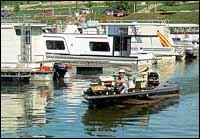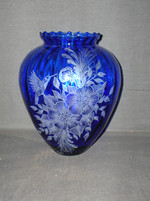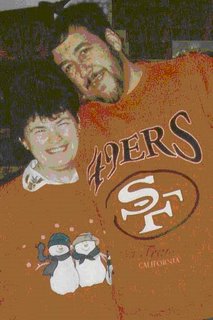We are keenly aware that there are parts of our heritage that are of particular importance. The system of one-and two-room schoolhouses is one of those parts of the past. They were at the heart of shaping and strengthening both the children and the little communities along the tiny creeks and runs. This entry tells of the journey one old school house took in 1989, from the past to the future, thanks to the determination of folks like you and me.  Above are three sides of the schoolhouse, before the move. Notice the six windows on one side and the boarded up windows on the other side. Clifford Wine explains this below. Toward the bottom of this entry is a picture of the school building today.
Above are three sides of the schoolhouse, before the move. Notice the six windows on one side and the boarded up windows on the other side. Clifford Wine explains this below. Toward the bottom of this entry is a picture of the school building today.
See also
~ The teachers and students of Pine Run School are in the entry Teachers & Students at Pine Run
~ The Rev Doctor Homer Heater's website which tells of his early years in a similar school neighboring the Oil Creek community at homerheater.com.
by David Parmer
For nearly fifty years, the children of Pine Run and Indian Fork sat in their one room school house, barefooted in warm weather, "dressed in calico and patches on each knee," eager to learn from the dedicated teachers of the their little school and secure in their own neighborhood. Today that building sits in a park 14 miles away by the way Uncle Zeke’s buzzards fly, 30 miles by truck. Re-erected, repainted, refitted, and lined with school desks, the Pine Run School never looked better and sits as if ready to receive students for a new school year. 
Pine Run is located about four miles northwest of downtown Orlando by Uncle Zeke’s buzzards. It is not in the Oil Creek watershed, which ends at Tully Ridge. It flows into the Little Kanawha via Indian Fork, then Sand Fork. Still, it has the address of Route 1, Orlando. Today this area seems closer to Weston and Burnsville, and it is hard to think of this area as part of Orlando. But when the trains still stopped in Orlando and the road to Weston still hugged the hills, winding up and down and around them, distances and the very shape of the land were different.
Here's the story of the school house. After the Lewis County Board of Education closed the Pine Run School in 1956, the property went back to the former owner of the land, the Heath family. Fonda (Heath) Pumpfrey became the owner of the abandoned Pine Run School. A solidly built building, the structure suitably served Mrs. Pumpfrey as a barn for hay, the storage of grain and other farming uses over the next forty years. The slate roof of the old school had a life of its own and kept the inside of the building free from deteriorating moisture.
.
In the early 1990s, planners within the state park system of the State of West Virginia felt that the state park system should display a typical one room school house at a state park for both tourists and West Virginians in order that the visitors could experience the feel of education in West Virginia in the early 1900s. Two ladies from Gilmer County, Wilda (Mohr) Jenkins and Louise White, spearheaded the search for a one room school building for use at Cedar Creek. Since all West Virginia one room schools had been closed for nearly fifty years, the problem was to find one which still was structurally sound. After a search, the Pine Run School was selected as a possible addition to the state park because it was still basically intact.
.
The building was about 24 x 28 in size and constructed of lap siding and a slate roof. A thick

slate blackboard crossed the back wall of the school. The walls, ceiling and floor were of fitted tongue and grove lumber, the walls and ceiling of poplar and the floor of oak. A pot-bellied stove was situated in the middle of the large room, with a flue extending upward through the ceiling to the outside. A small cloak room was situated in the right rear corner of the building. A school bell was outside mounted on the front gable. A unique aspect of the school was the hand pump water well which was located on the front porch of the school. A former student,
Clifford Wine, who grew up on Indian Fork and attended Pine Run School for nine terms, which included an extra year after the eighth grade, recalls that the floors of the school would receive an annual treatment of linseed oil as a preservative.

Clifford Wine also points out that at one time the school had windows on both sides of the building, but the school authorities determined that it was best if daylight came from over the left shoulders of the students as they sat at their desks. For that reason the windows on one side of the school building was boarded up.
Above left is a closeup of the porch showing the pump Mr Wine mentions.
To the right and below left the two parts of Pine Run school are being loaded for removal to the state park.
Will The Old School Fly?
The plan to move the school called for a steel frame to be constructed and put under the building. The school would then to be lofted airborne by a National Guard helicopter, and moved to the grounds of Cedar Creek State Park in Gilmer County, nearly fourteen air miles away. The school would then be re-erected, re-fitted with chalkboard, desks, a school bell and all of the other amenities of an early one room school in West Virginia and put on display. It was an interesting, exciting, and, a seemingly workable plan. Preparations for the great airlift were made and the day for the event soon came. The roof had been removed from the school down to the roof trusses. The steel frame had been built and put under the school. The National Guard helicopter and pilot requisitioned for the occasion made an

appearance at Pine Run. However, after a reconnoiter of the site and a logistical review of the prepared building, the pilot determined that the task was too great for a move by helicopter and the mission was aborted. Thus, the school house which was to fly suffered cropped wings and remained on the ground.
.
Maybe by Land
For close to two years the Pine Run School sat on the ground, open to weather and the elements, and deterioration sat in.
Carl Carr, the owner of a construction company in Sand Fork, was aware of the problem encountered in moving the building. Carr proposed to remove the roof trusses and saw the building in half. The school would then be loaded onto a low boy and moved. By land, the distance between Pine Run and Cedar Creek is about thirty miles. The State agreed to Mr. Carr’s proposal, and the school building which was supposed to fly was to be moved by wheels instead.

So it was that the Pine Run School was loaded onto low boy trailers and moved to Cedar Creek by truck. Mr. Carr moved the building up the Indian Fork Road, then up Goosepen Road to Interstate 79, where he then headed south on the interstate to Burnsville. Getting off the interstate at Burnsville, Mr. Carr moved the Pine Run School through Gem, Copen and Cedarville to Cedar Creek State Park. Aside from a couple tight fitting bridges, and a couple of low hanging telephone lines at Copen and Cedarville, the move went slowly but smoothly for nine hours.
Next, two of the people who were there tell the story: first Carl Carr, then Wilda Mohr Jenkins.
I remember well the move of the Pine Run School on Indian Fork to Cedar Creek State Park. After the National Guard had given up on the idea of moving the school building by air, I contacted Mr. Radabaugh of the State School Superintendent’s Office with a proposal. Mr. Radabaugh, who lived in the Cedar Creek area, approved the plan.
I was assisted in the movement of the school by Danny Self of Dusk Camp, and his helper Eric; by my father in law, Foster Batten who acted as a flagger and Dice Steele who also acted as a flagger.
.
We removed the roof trusses from the building prior to the move. I noticed initials of former students carved on doors as we were preparing

the building to be moved.
The movement of the building went fairly well. We went south on Interstate 79 to Burnsville, then through Gem, Copen and Cedarville. After getting the building to Cedar Creek, we re-erected the building on a prepared site. The old tongue and grooved ceiling had been removed or had rotted away previously when the National Guard had planned on moving the building. I was able to secure replacement yellow poplar tongue and grooved boards from an old elementary school at Sand Fork to replace the ceiling. The old red oak roof trusses which were removed as we
.jpg)
prepared to move the building were so brittle that they snapped as they were removed and they had to be replaced.
.
An old bell for the school was located in Clarksburg. I also built a flagstone walkway at the new school site and a monument commemorating the service of school teachers.
The old Pine Run School building would be an excellent field trip for school children in central West Virginia so that they could get a taste of what schools used to be in the days gone by.
.
This is how the old school looks today, in its new home at Cedar Creek State Park. Click on it and the other photos to enlarge.
Wilda (Mohr) Jenkins tells us. . .
Pine Run School
If I Could Talk
By Wilda (Mohr) Jenkins
My door was closed in Nineteen Hundred Fifty-Six,
And I was loaded with hay and sticks.
For thirty years I stood idle as could be,
I was falling apart, it was plain to see.
.
Then one day a lady came looking for me
And my owner replied "just leave it be."
These people insisted…I needed preserved.
I thought, "this sounds rather absurd."
They looked at my windows…cracked and broke;
I think some felt it was only a joke.
Then came the day…I was finally sold,
"What do they want with me? Now that I’m old?"
They removed my roof which was made of slate
And I’m wondering…"What is going to be my fate?"
They cut braces and braced my walls
I guess they thought I was going to fall.
.
The helicopters from the National Guard
Flew over my roof and landed in my yard.
I listened as I heard them sigh
They were planning …to make me fly.
.
This didn’t work and winter was coming on
And still they were singin’ the same ole’ song.
For two years I sat there…I was falling apart
My roof was all covered with plastic and tarps.
They said…"We’ll move you as you are."
Then came the day and this fine…Mr. Carr,
He ripped off my roof clear down to the square
I thought it was the end of me…I do declare.
They used wrecking bars and hammers with claws,
Sawed me in the middle with a big chain saw.
I just knew I was done for…I was filled with rain
And wished that I was still full of grain.
They loaded me on this great big truck
I wondered about the bridges…perhaps we’d get stuck.
Danny and Aaron worked as Mr. Carr’s side kick
They protected me…they knew the right lick.
We finally started down the highway, moving very slow,
The other half of me behind…still in tow.
We fought the bushes and the heat as well
And how we ever made it…I’ll never tell.
But after seven hours of sweat and fear
Cedar Creek Park finally drew near.
Once we got there my name some started to swear
I heard some say "What’s this pile of junk doing here?"
I was left there for a week or two
I was wondering "Now what are they going to do?"
It didn’t take long to put me together
New roof and all…to protect from the weather.
.
My windows were done and they added new glass,
Finally I could stand here and do it with class.
My old paint was peeling and starting to fall,
So they scraped and sanded and washed me and all.
.
The came my new coat of snowy white paint
These people worked hard I thought they would faint.
They covered me all over both inside and out
And had I been human…I know I would shout.
.
New wires for my old fashioned oil lights;
Finally I’m becoming a beautiful sight.
New porch, new roof and a big bell to ring,
I’m pretty well complete, I have everything.
Flue stones and a new chimney for smoke,
These people mean business and that’s no joke;
An old fashioned oil lantern…to guide your way,
It is hanging on my porch…it is here to stay.
.
My desks are all reworked…they really look fine,
I was a lost part of history…one of a kind.
My blackboard and pot-bellied all in place
My whole being was given a new face.
A water cooler sets in the corner on a shelf
With an old tin cup, "please help yourself."
A big coal bucket black from coal
To be complete and old fashioned is my goal.
.
New floor, new ceiling…just like I had,
I don’t know why…I was ever so sad.
I never thought I would be as good as new
So crisp and white…fresh as morning dew.
I want to be truthful as here I stand
I never dreamed I would ever look so grand.
I don’t have the words at my command
I hope by some means you can understand.
I’m not bragging…My appreciation I want to show,
I’m glad to be here in the park…I want the world to know.
I know I’m old fashioned…simple as can be,
My students dressed in calico and patches on each knee.
Although I’m simple and growing very old,
I think I’m rather pretty….with stories to be told.
Now that I’m fully preserved…I have a lot to give,
I would like to tell your children…how you used to live.
.
I thank you for your kindness and loyalty shown me
For placing me here for everyone to see.
Please come and visit me often…to teach is my desire
I hope that eager minds will come to me to inquire.
Comments
comment 1 by David Parmer
Check out the
July 27, 1989 article from the Glenville Democrat from
Charles McNemar It reported on the move of the Pine Run School to Cedar Creek State Park. The writer of the article,
Wilda Jenkins, was also instrumental in the move of the school itself. Ms. Jenkins reported that
Carl Carr, along with
Danny Self and
Aaron Bennett, moved the school building over a route of 49 miles and averaged seven miles per hour. Thanks, Charles.
The Pine Run School was also featured in an article in the May 1992 issue of
Wonderful West Virginia magazine. According to the author, Maureen Crockett, the Pine Run School was built in 1910. The article mentions that a Committee for Cedar Creek State Park had been appointed to locate a one room school house to be re-located at the park and that the Committee, after

some arduous bargaining, finally convinced
Fonda Pumphrey to surrender ownership of the Pine Run school building for the park project.
.
comment 2 by David Parmer
The Ben’s Run School (pictured to the right, was the last one room school in Lewis County.
.
comment 3 by Donna Gloff
We believe this is the Rocky Fork school, Pine Run's close neighbor.
To the left, the exterior of the Rocky Fork school. Note the similarities with the Pine Run School.
To the right is the interior of the Rocky Fork school during one of the WPA adult classes.
 by Patsy Reckart
by Patsy Reckart
 The meeting was then turned over to the Slim Quinton Blue Grass Gospel Band, who entertained the crowd with their wonderful music, getting wound up in the music Pat and Marilyn showed the crowd they were not to old to kick up their heels a little bit.
The meeting was then turned over to the Slim Quinton Blue Grass Gospel Band, who entertained the crowd with their wonderful music, getting wound up in the music Pat and Marilyn showed the crowd they were not to old to kick up their heels a little bit. 








.jpg)





















